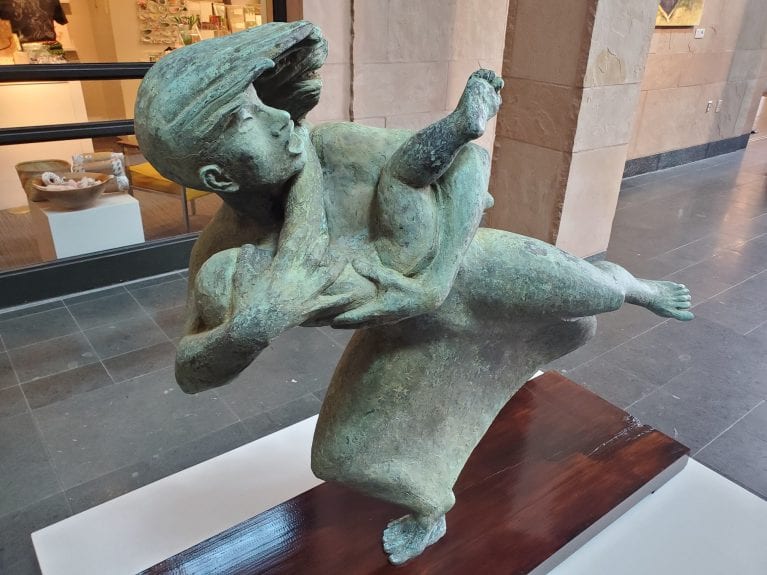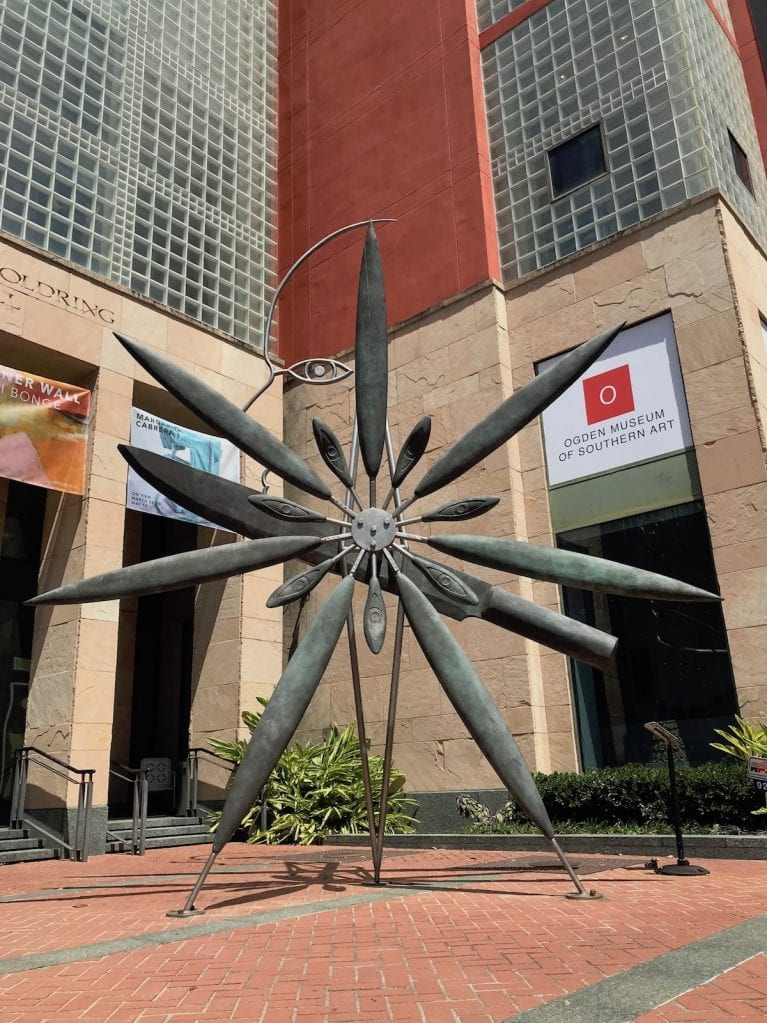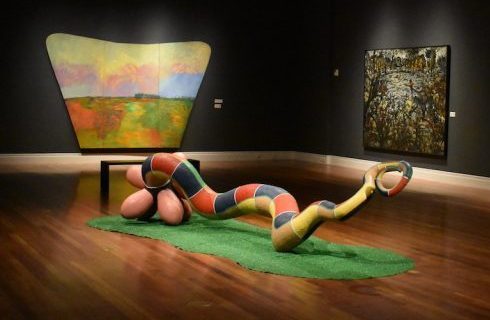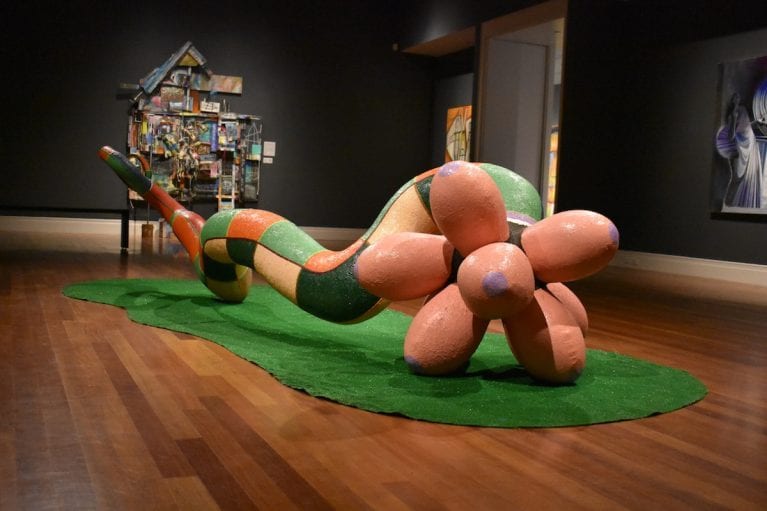Español abajo
Infuse life into a sculpture by recreating it with your own body!
Download Activity
Image A – Enrique Alférez, “La Vietnamita – Mother in Flight“
Sculpture is an artistic form in which materials are worked into three-dimensional objects. Sculptures take more volume in space compared to two-dimensional objects such as paintings or drawings for example. An enormous variety of media may be used to create a sculpture such as clay, wax, stone, metal, fabric, glass, wood, plaster, rubber, and found objects.
Sculptures are usually still. However, some of them depict the idea of movement or can even be kinetic sculptures in which movement is a crucial part of the artwork.
Instructions
Step 1: Change into comfortable clothes. Make sure you have enough space around you to move safely. Take a couple of deep breaths and stretch your body.
Step 2: Let’s look at Image A. Carefully observe the position of the woman in the sculpture. Time to move! Try to recreate her position and stand still for a few seconds. Now, look more specifically at the expression on her face and think about how she might be feeling. Get back into the full position from before, but this time convey a feeling by changing your facial expression.

Image B – James Surls, Me, Knife, Diamond and Flower, 2000, Cast bronze and stainless steel, On loan from the Helis Foundation
Step 3: Study Image B. This sculpture is more abstract than the first one. Can you find the eyes and the nose in the sculpture? Turn your head to the side to recreate the profile of the face in the sculpture. Think about how you can recreate the shapes and elements of the sculptures with your body. Get into position. Hold it for a few seconds.

Image C – Jim Roche, Loch Ness Mama, 1970, acrylic on canvas, foam, fiberglass resin, and powdered asbestos
Step 4: Time for Image C. What does this sculpture remind you of? Try to recreate the shape of it with your body. Notice the colors in the sculpture. How does each color make you feel? How can you express these feelings by changing the position of your body? Finally, recreate what you think the movement of the sculpture would be if it could move.
Step 5 (Optional): Find new images of sculptures on the internet or in books and try to recreate them like we just did. Have fun!
Vocabulary
Abstract – art that does not attempt to represent an accurate depiction of a visual reality but instead use shapes, colors, forms to achieve its effect. For example, abstract art does not depict directly a person, place, or thing in the natural world as they are seen usually. It is not realistic.
Kinetic art – The word kinetic means relating to motion. Kinetic art is art from any medium that contains movement perceivable by the viewer or depends on motion for its effect.
SEE MORE FUN AT-HOME ACTIVITIES FOR KIDS ON OGDEN MUSEUM ONLINE!
QUESTIONS? EMAIL EDUCATION@OGDENMUSEUM.ORG.

Lunes de movimiento: Esculturas vivientes
¡Dale vida a una escultura recreándola con tu propio cuerpo!

Imagen A – Enrique Alférez, “La Vietnamita – Mother in Flight”| Enrique Alférez, “La Vietnamita – Madre en vuelo”
La escultura es una forma artística en la cual los materiales utilizados son objetos tridimensionales. Las esculturas ocupan un mayor volumen en el espacio, comparado con los objetos bidimensionales como las pinturas o los dibujos. Se puede utilizar una gran variedad de materiales para crear una escultura, como la arcilla, cera, piedra, metal, tela, vidrio, madera, yeso, caucho y objetos encontrados.
Las esculturas suelen estar fijas. Sin embargo, algunas representan la idea de movimiento o pueden ser esculturas cinéticas en las que el movimiento es una parte crucial de la obra de arte.
Instrucciones
Paso 1: Asegúrate de tener suficiente espacio a tu alrededor para moverte con seguridad. Respira profundamente un par de veces y estira el cuerpo.
Paso 2: Veamos la Imagen A. Observa cuidadosamente la posición de la mujer en la escultura. ¡Hora de moverse! Intenta recrear su posición y quédate quieto/a durante unos segundos. Ahora, mira más específicamente la expresión de su rostro y piensa en cómo podría sentirse. Vuelve a la posición completa de antes, pero esta vez transmite un sentimiento cambiando tu expresión facial.

Imagen B – James Surls, Me, Knife, Diamond and Flower, 2000, Cast bronze and stainless steel, On loan from the Helis Foundation | James Surls, Yo, cuchillo, diamante y flor, 2000, Bronce fundido y acero inoxidable, En préstamo de la Fundación Helis
Paso 3: Estudia la Imagen B en la segunda página. Esta escultura es más abstracta que la primera. ¿Puedes encontrar los ojos y la nariz en la escultura? Gira la cabeza hacia un lado para recrear el perfil del rostro en la escultura. Piensa en cómo puedes recrear las formas y los elementos de las esculturas con tu cuerpo. Ponte en posición. Mantenlo por unos segundos.

Imagen C – Jim Roche, Loch Ness Mama, 1970, acrylic on canvas, foam, fiberglass resin, and powdered asbestos | Jim Roche, Mama del Lago Ness, 1970, acrílico sobre lienzo, espuma, resina de fibra de vidrio y asbesto en polvo
Paso 4: Ahora observa la Imagen C en la segunda página. ¿A qué te recuerda esta escultura? Intenta recrear la forma qué te recuerda esta escultura? Intenta recrear la forma con tu cuerpo. Observa los colores de la escultura. ¿Cómo te hace sentir cada color? ¿Cómo puedes expresar estos sentimientos cambiando la posición de tu cuerpo? Finalmente, recrea lo que crees que sería el movimiento de la escultura si pudiera moverse.
Paso 5 (Opcional): Encuentra nuevas imágenes de esculturas en el Internet o en libros e intenta recrearlas como acabamos de hacer. ¡Diviértete!
Vocabulario
Abstracto: arte que no intenta representar una descripción precisa de una realidad visual, sino que utiliza formas y colores para lograr su efecto. Por ejemplo, el arte abstracto no representa directamente a una persona, un lugar o una cosa en el mundo natural como se los ve habitualmente. No es realista.
Arte cinético: la palabra “cinético” significa relativo al movimiento. El arte cinético es arte de cualquier medio que contenga movimiento perceptible por el espectador o que dependa del movimiento para su efecto.
¡VE MÁS ACTIVIDADES DIVERTIDAS PARA NIÑOS PARA HACER EN CASA EN OGDEN MUSEUM ONLINE!
¿PREGUNTAS? ENVÍA UN EMAIL A EDUCATION@OGDENMUSEUM.ORG.
Translation by Agostina Coll

